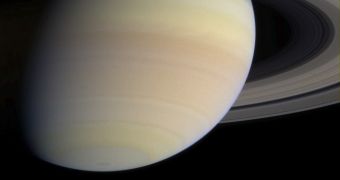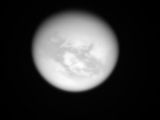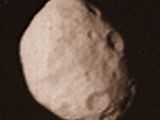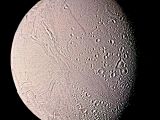Saturn, the sixth planet from the Sun, is a gas giant and the second largest in the solar system. Its weird properties, its rings and its large number of moons - the precise figure is uncertain - make the Saturnian system a freak show, attracting the attention of amateur and professional astronomers worldwide.
First of all, it's not a sphere, being flattened at the poles and bulky at the equator. The Earth is not a sphere either, but Saturn's equatorial and polar diameters differ by almost 10% (120,536 km vs. 108,728 km).
Its cloud patterns, in natural light, are the color of butterscotch, with only subtle variations in the cloud bands. The atmosphere is full of sinuous whorls, ripples and huge hurricanes. Saturn's winds are among the Solar System's fastest. Voyager data indicate peak easterly winds of 500 m/s (1116 mph). In 1990, the Hubble Space Telescope observed an enormous white cloud near Saturn's equator, which was not present during the Voyager encounters, and in 1994, another smaller storm was observed.
Its rings are also spectacular. It seems the astronomers were wrong at approximating the mass of the rings, which were thought to be consisting mostly of lightweight ice particles with a smaller amount of rocky debris and dust. The new observations point to them being two or more times more massive than previously thought.
Another strange feature is Saturn's hexagon at its South Pole. This is a very strange feature, lying in a precise geometric fashion with six nearly equally straight sides. Saturn's thick atmosphere where circularly-shaped waves and convective cells dominate is perhaps the last place where you'd expect to see such a six-sided geometric figure, yet there it is.
Strange as it may seem, Saturn radiates 2.8 times as much heat as it receives from the Sun. This was supposed to be caused by the auroras observed at Saturn's poles. Some completely unknown process would then transfer this heat to the equator. This unexplained energy crisis represents a major gap in the understanding of this planets' atmosphere.
Saturn's magnetic field is yet another mystery, with recent data showing a vast magnetosphere, the invisible bubble of magnetic fields, electric currents, and trapped radiation far larger than the ringed planet itself.
Saturn's satellites are another intriguing aspect, making them an important part of the show. As of 2007, a total of 57 individual moons have been identified, plus 3 unconfirmed moons that could be small dust clumps in the rings. 35 moons have been named. Many of the moons are very small: out of 57, 31 are less than 10 km in diameter, and another 13 less than 50 km.
Titan is the mysterious star of the show when it comes to Saturn's moons. It's the only moon in the solar system to have an opaque atmosphere, which is composed of hydrocarbon smog.
It's the largest moon of Saturn and the second largest moon in the solar system, after Jupiter's moon Ganymede. It is roughly 50% larger than the Earth's moon by diameter, and is larger by diameter and mass than all known dwarf planets. It is also larger by diameter than the planet Mercury, though Mercury is more than twice as massive.
One of the satellite's curiosities is a strange radio signal emitted at an extremely low frequency. So far, no one was able to pinpoint the origin and what causes this signal, since the only other world on which ELF waves were detected before was Earth.
Another one of Saturn's moons is Janus, a small satellite looking like a pebble sailing over Saturn's clouds, having only 178 km in diameter. The problem with Janus was the fact that it occupies essentially the same orbit as the moon Epimetheus, causing some confusion for astronomers, who assumed that there was only one body in that orbit, and for a long time struggled to figure out what was going on.
The geysers on the Saturn's moon Enceladus are one of the most spectacular shows in our solar system. In 2006, NASA's Cassini spacecraft discovered in 2006 plumes of icy water vapors that kept intriguing astronomers ever since. Early theories suggested the geysers could be generated by liquid water under the surface of the satellite that instantly freezes when hurled into space. This led to speculations about the existence of lifeforms in an underground layer of liquid water, but it was later proved that the geysers were the ones responsible for the lack of life on the satellite.
So, it seems Saturn will remain an astronomical attraction for many years, at least since we'll be able to send more probes to clear the picture, and who knows, maybe, in the not so distant future, the planet will become a real tourist attraction for space travel agencies.

 14 DAY TRIAL //
14 DAY TRIAL // 


